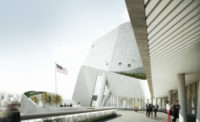Karim Rashid Brings Kool-Aid Colors and Curves to Manhattan Condo Buildings
























If New York Mayor Bill de Blasio wants affordable housing that isn’t cookie-cutter, perhaps he should consult Karim Rashid. At 53, Rashid is best known for designing household products. But now he wants to design households for those products, and he is getting his wish: among his current projects are four Manhattan condo buildings, the first of which is already under construction. Though they are recognizably Rashid’s—with ample curves and Kool-Aid colors—they are also economical, with construction costs of about $250 per square foot. (The typical cost of new residential construction in Manhattan is nearly twice that much.)
As an industrial designer, Rashid has some 3,000 items in production, according to Michael Regan, the chief operating officer of Karim Rashid Inc. (The firm operates out of a sprawling loft-like space—part of a complex designed by Smith-Miller + Hawkinson Architects—in the Hell’s Kitchen section of Manhattan.) But Rashid says he has longed to design buildings, and the opportunity came his way after he gave a talk in Tel Aviv. The Egyptian-born designer found himself chatting with an Israeli real estate developer about the shortage of entry-level condos in New York. Through his company, Hap Investments, the developer entrusted Rashid with four Manhattan parcels— three uptown and one in Chelsea—and soon Rashid was working to give them buildings as distinctive as his sofas, wastebaskets, and baby bottles.
A building on Pleasant Avenue, called HAP 5, broke ground in April. Its balconies, with glass railings in blue and pink (Rashid calls the colors cyan and watermelon), will be jarring in a neighborhood of brick townhouses and tenements. But Rashid says the facade isn’t the point, that after 30 years designing products to be touched and held, he is most focused on making the interiors efficient. To save money, there are no dropped ceilings, only exposed concrete slabs. That left no way to recess overhead fixtures; instead, Rashid created coves, below the ceilings, from which indirect lighting emerges. Floors are made of biodegradable wood sheets with colorful patterns designed by Rashid, who has a knack for making natural materials look alien. “Sustainable does not have to be granola looking,” he explains.
Rashid has also chosen his own wall coverings, bathroom fixtures, and hardware for the units. Manufacturers give him a discount, which helps keep construction costs down. The developer will be selling the condos at $500,000 or more, but in Manhattan, where the median condo or co-op price is about $1 million, that’s considered affordable.
The second building, HAP 4, on West 187th Street, looks very different; its front façade consists of Tetris-like panels in shades of blue and grey. (The units in that building will be prefabricated in Pennsylvania.) Even more arresting is HAP 6, on upper Madison Avenue, which, like HAP 4, is in the construction document phase. This time, the palette is restrained but the patterns suggest a distorted space frame, like Buckminster Fuller on acid. The building’s side wall, facing a playground, is particularly ingenious: it’s on a lot line, which meant Rashid was limited to 10 percent glass. Most developers respond to lot-line regulations with tiny, conventional windows in otherwise bland surfaces. Rashid turned the entire wall into an artwork, reminiscent of an abstract painting but incorporating triangular windows. He pulled off a similar trick at HAP 5, where partitions between balconies must be 50 percent open. Rashid designed glass reinforced fiber concrete panels with perforations that satisfy zoning regulations but sacrifice as little privacy as possible.
Rashid, the brother of architect Hani Rashid of Asymptote, is assisted by Alex Loyer Hughes, an architect who joined his firm in 2012 and, in addition to the Manhattan projects, is working on buildings as far away as Latvia, Tel Aviv, and Miami. In New York, Karl Fischer Architects and WASA (Wank Adams Slavin Associates LLP) have been producing the construction documents.
Hughes, an alumnus of Peter Marino’s office, finds himself working in a candy colored universe. “People come to us because they want pink,” he says of the firm's clients. But there is more to these projects than Rashid’s overweening aesthetic. While buildings are usually designed in feet and inches, Rashid works in millimeters, and while architects too often let contractors decide where thing like pipes and ductwork go, Rashid places every element himself. His methods, those of an industrial designer, may prove to be a big advantage in the building game.














